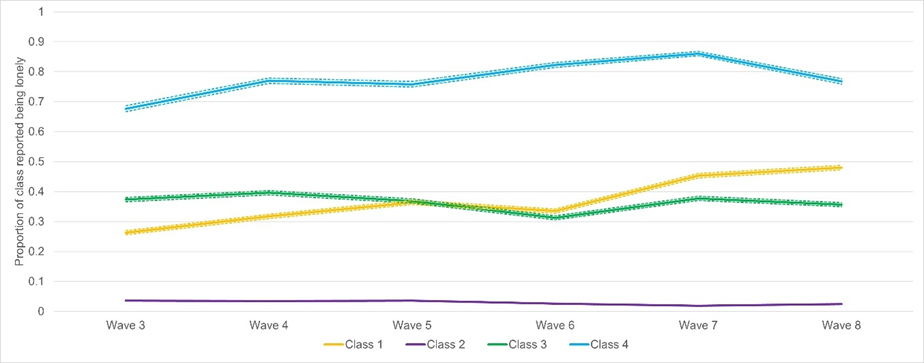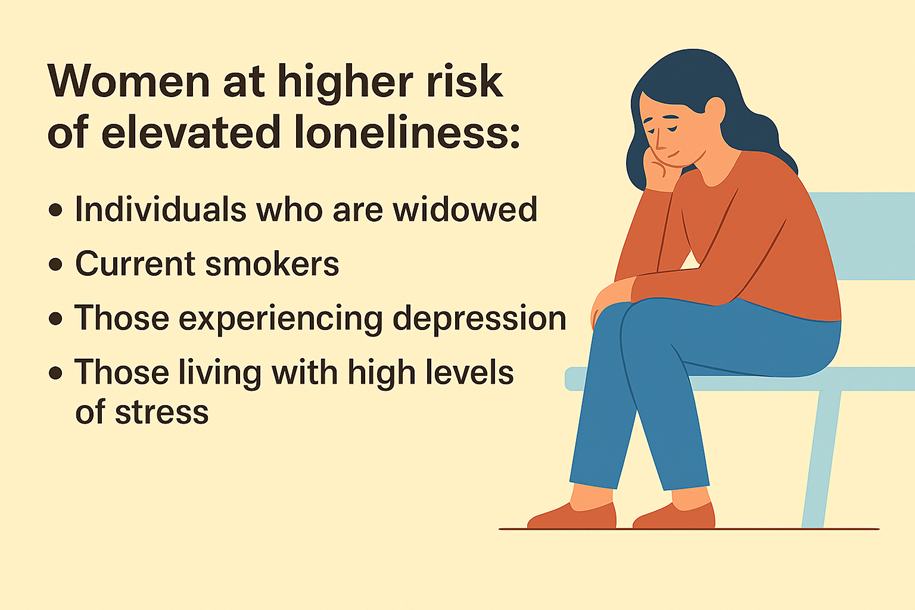From Low to Rising- How Loneliness Trends Shape Women’s Health Over Time
Published in Healthcare & Nursing, Social Sciences, and Public Health

Loneliness arises from dissatisfaction with the quantity or quality of our social interactions and relationships. It’s an emotion we all experience, yet persistent loneliness can become a chronic condition that quietly erodes health. Over the past few years, loneliness has become a public health buzzword, especially during and after the COVID-19 pandemic. Yet long before the pandemic brought it into the spotlight, loneliness had already been silently affecting the health of millions, particularly among middle-aged and older adults. While previous studies suggested links between loneliness and poor health, few have examined these associations over time, and even fewer have tried to understand how different loneliness experiences unfold throughout adulthood.
Our team set out to better understand how loneliness unfolds over time and what consequences it may have for women’s health and well-being. Our paper used 18 years of longitudinal data to examine how different patterns of loneliness impact health-related quality of life (HRQoL) in middle-aged and older Australian women. The study focused on the 1946–51 cohort, who were in their 40s-50s at the start of the study and followed into their 60s-70s.
What did we find?
Using a latent class analysis, our findings revealed distinct trajectories of loneliness. We found four distinct groups:
- Increasing loneliness (74% of the sample)
- Stable-low loneliness (5%)
- Stable-medium loneliness (17%)
- Stable-high loneliness (4%)
Probabilities of loneliness for each loneliness class over time (n = 13,714)

Class 1 = ‘Increasing’ loneliness; Class 2 = ‘Stable-low’ loneliness; Class 3 = ‘Stable-medium’ loneliness; Class 4 = ‘Stable-high’ loneliness
----- 95% Confidence intervals
Our analyses showed that women who were widowed, current smokers, or living with depression or stress at baseline were more likely to follow trajectories of increasing, Stable-medium and Stable-high loneliness. We found that all trajectories of Stable-medium, Stable-high or rising loneliness were associated with lower HRQoL scores, especially in the mental health domain. Women in the Stable-high loneliness group had the poorest HRQoL outcomes across nearly all measures, including mental health and physical and social functioning. The Increasing loneliness group also showed declines in physical and mental health-related quality of life.
What are the implications?
Our findings reveal that loneliness does not occur in isolation. It is closely linked with health, health behaviours, and life circumstances such as bereavement, smoking, and chronic stress. In addition, our findings challenge the stereotype that loneliness only affects a small, marginalised segment of the population. Instead, our findings suggest that loneliness is a widespread and growing experience for many women transitioning from midlife into older adulthood. What was particularly striking was that even moderate levels of loneliness were significantly associated with poorer physical and mental health outcomes over time. This challenges the belief that only “severe” loneliness warrants intervention. In reality, persistent moderate loneliness can carry serious health risks, underscoring the importance of early identification and support. Waiting until loneliness becomes severe may be too late- preventive and proactive strategies are crucial for long-term health and well-being.

What can we do about it?
Our findings highlight that loneliness is a serious health risk, comparable to other health risks such as diet, physical inactivity, and smoking and should be recognised as a major public health priority. Yet, despite its impact, loneliness remains largely overlooked in public health campaigns. While some non-profit and healthcare organisations have introduced intervention and prevention programs to address it, these efforts often fall short given the scale of the issue and the lack of consistent funding and human resources. There is an urgent need for systematic, early identification and intervention strategies to prevent chronic loneliness. Regular screening in primary care, especially among women entering older adulthood, could play a key role in improving long-term health outcomes.
Although our study is based on data from a high-income country, loneliness is a global issue. Emerging evidence suggests that it may be even more prevalent and harmful in low-income settings. To develop effective solutions, future research must include underrepresented populations, such as culturally diverse communities. Expanding data collection to encompass a wider range of countries and populations will be vital to uncovering how cultural contexts shape experiences of loneliness and their impact on health-related quality of life.
Ultimately, this expanding body of research should aim to answer a fundamental question: how can we build a society in which fewer people feel lonely?
Follow the Topic
-
Communications Psychology

An open-access journal from Nature Portfolio publishing high-quality research, reviews and commentary. The scope of the journal includes all of the psychological sciences.
Related Collections
With Collections, you can get published faster and increase your visibility.
Replication and generalization
Publishing Model: Open Access
Deadline: Dec 31, 2025
Intensive Longitudinal Designs in Psychology
Publishing Model: Open Access
Deadline: Mar 31, 2026




Please sign in or register for FREE
If you are a registered user on Research Communities by Springer Nature, please sign in